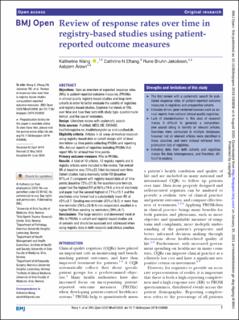| dc.contributor.author | Wang, Katherine | |
| dc.contributor.author | Eftang, Cathrine N. | |
| dc.contributor.author | Jakobsen, Rune Bruhn | |
| dc.contributor.author | Årøen, Asbjørn | |
| dc.date.accessioned | 2021-02-02T10:36:09Z | |
| dc.date.available | 2021-02-02T10:36:09Z | |
| dc.date.created | 2020-09-25T10:41:03Z | |
| dc.date.issued | 2020 | |
| dc.identifier.citation | BMJ Open. 2020, 10(8), e030808. | en_US |
| dc.identifier.issn | 2044-6055 | |
| dc.identifier.uri | https://hdl.handle.net/11250/2725759 | |
| dc.description | This is an open access article distributed in accordance with the Creative Commons Attribution Non Commercial (CC BY-NC 4.0) license, which permits others to distribute, remix, adapt, build upon this work non-commercially, and license their derivative works on different terms, provided the original work is properly cited, appropriate credit is given, any changes made indicated, and the use is non-commercial. See: http://creativecommons.org/licenses/by-nc/4.0/. | en_US |
| dc.description.abstract | Objectives: Gain an overview of expected response rates (RRs) to patient-reported outcome measures (PROMs) in clinical quality registry-based studies and long-term cohorts in order to better evaluate the validity of registries and registry-based studies. Examine the trends of RRs over time and how they vary with study type, questionnaire format, and the use of reminders.
Design: Literature review with systematic search.
Data sources: PubMed, MEDLINE, EMBASE, kvalitetsregistre.no, kvalitetsregister.se and sundhed.dk.
Eligibility criteria: Articles in all areas of medical research using registry-based data or cohort design with at least two follow-up time points collecting PROMs and reporting RRs. Annual reports of registries including PROMs that report RRs for at least two time points.
Primary outcome measure: RRs to PROMs.
Results: A total of 10 articles, 12 registry reports and 6 registry articles were included in the review. The overall RR at baseline was 75%±22.1 but decreased over time. Cohort studies had a markedly better RR (baseline 97%±4.7) compared with registry-based data at all time points (baseline 72%±21.8). For questionnaire formats, paper had the highest RR at 86%±19.4, a mix of electronic and paper had the second highest at 71%±15.1 and the electronic-only format had a substantially lower RR at 42%±8.7. Sending one reminder (82%±16.5) or more than one reminder (76%±20.9) to non-responders resulted in a higher RR than sending no reminders (39%±6.7).
Conclusions: The large variation and downward trend of RRs to PROMs in cohort and registry-based studies are of concern and should be assessed and addressed when using registry data in both research and clinical practice. | en_US |
| dc.language.iso | eng | en_US |
| dc.subject | PROM | en_US |
| dc.subject | patient reported outcome measure | en_US |
| dc.subject | registries | en_US |
| dc.subject | response rate | en_US |
| dc.title | Review of response rates over time in registry-based studies using patient-reported outcome measures | en_US |
| dc.type | Peer reviewed | en_US |
| dc.type | Journal article | en_US |
| dc.description.version | publishedVersion | en_US |
| dc.rights.holder | © Author(s) (or their employer(s)) 2020 | en_US |
| dc.source.pagenumber | 9 | en_US |
| dc.source.volume | 10 | en_US |
| dc.source.journal | BMJ Open | en_US |
| dc.source.issue | 8 | en_US |
| dc.identifier.doi | 10.1136/bmjopen-2019-030808 | |
| dc.identifier.cristin | 1833371 | |
| dc.description.localcode | Institutt for idrettsmedisinske fag / Department of Sports Medicine | en_US |
| dc.source.articlenumber | e030808 | en_US |
| cristin.ispublished | true | |
| cristin.fulltext | original | |
| cristin.qualitycode | 1 | |
